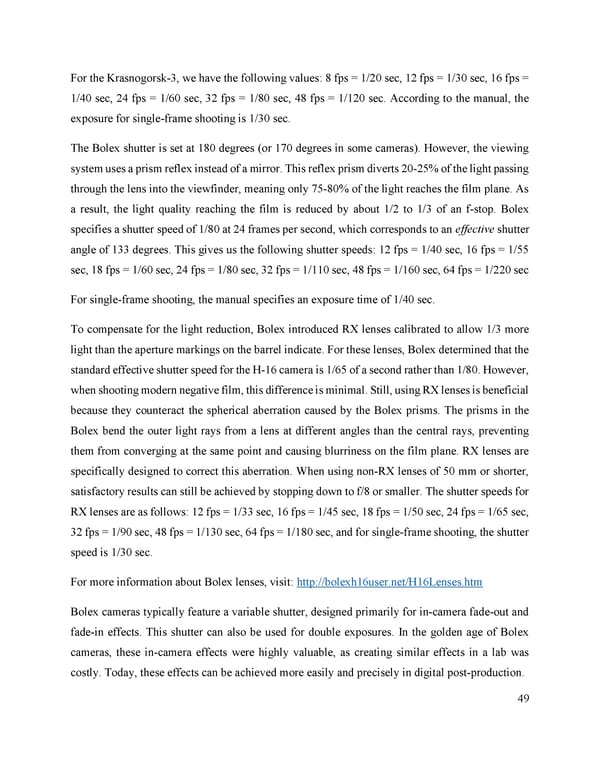For the Krasnogorsk-3, we have the following values: 8 fps = 1/20 sec, 12 fps = 1/30 sec, 16 fps = 1/40 sec, 24 fps = 1/60 sec, 32 fps = 1/80 sec, 48 fps = 1/120 sec. According to the manual, the exposure for single-frame shooting is 1/30 sec. The Bolex shutter is set at 180 degrees (or 170 degrees in some cameras). However, the viewing system uses a prism reflex instead of a mirror. This reflex prism diverts 20-25% of the light passing through the lens into the viewfinder, meaning only 75-80% of the light reaches the film plane. As a result, the light quality reaching the film is reduced by about 1/2 to 1/3 of an f-stop. Bolex specifies a shutter speed of 1/80 at 24 frames per second, which corresponds to an effective shutter angle of 133 degrees. This gives us the following shutter speeds: 12 fps = 1/40 sec, 16 fps = 1/55 sec, 18 fps = 1/60 sec, 24 fps = 1/80 sec, 32 fps = 1/110 sec, 48 fps = 1/160 sec, 64 fps = 1/220 sec For single-frame shooting, the manual specifies an exposure time of 1/40 sec. To compensate for the light reduction, Bolex introduced RX lenses calibrated to allow 1/3 more light than the aperture markings on the barrel indicate. For these lenses, Bolex determined that the standard effective shutter speed for the H-16 camera is 1/65 of a second rather than 1/80. However, when shooting modern negative film, this difference is minimal. Still, using RX lenses is beneficial because they counteract the spherical aberration caused by the Bolex prisms. The prisms in the Bolex bend the outer light rays from a lens at different angles than the central rays, preventing them from converging at the same point and causing blurriness on the film plane. RX lenses are specifically designed to correct this aberration. When using non-RX lenses of 50 mm or shorter, satisfactory results can still be achieved by stopping down to f/8 or smaller. The shutter speeds for RX lenses are as follows: 12 fps = 1/33 sec, 16 fps = 1/45 sec, 18 fps = 1/50 sec, 24 fps = 1/65 sec, 32 fps = 1/90 sec, 48 fps = 1/130 sec, 64 fps = 1/180 sec, and for single-frame shooting, the shutter speed is 1/30 sec. For more information about Bolex lenses, visit: http://bolexh16user.net/H16Lenses.htm Bolex cameras typically feature a variable shutter, designed primarily for in-camera fade-out and fade-in effects. This shutter can also be used for double exposures. In the golden age of Bolex cameras, these in-camera effects were highly valuable, as creating similar effects in a lab was costly. Today, these effects can be achieved more easily and precisely in digital post-production. 49
 Lost Analogue: Exploring Film, Music, and Interdisciplinary Methods in Education Page 49 Page 51
Lost Analogue: Exploring Film, Music, and Interdisciplinary Methods in Education Page 49 Page 51